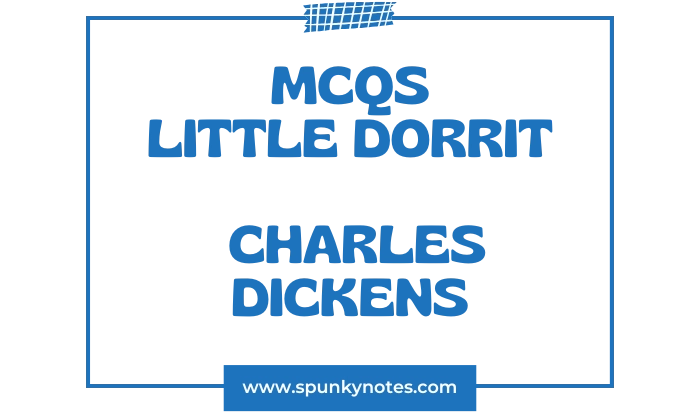

Estimated Reading Time: 19 min
Little Dorrit MCQs
1. Where was the novel’s opening scene set thirty years ago?
A. London
B. Paris
C. Marseilles
D. Toulon
2. Who is the reserved Englishwoman who questions whether a prisoner forgives his prison?
A. Pet
B. Mrs Meagles
C. Miss Wade
D. Tattycoram
3. Where was Arthur Clennam sitting when he arrived in London?
A. At a hotel in Dover
B. Window of a coffee-house on Ludgate Hill
C. In his mother’s house
D. At St Paul’s Cathedral
4. What was the title of the horrible tract that scared Arthur in his childhood?
A. The Sinner’s Guide
B. Why he was going to Perdition
C. The Wages of Sin
D. The Fiery Pit
5. How long had the fire been in the grate, night and day, in Mrs Clennam’s room?
A. Fifteen months
B. One year
C. Fifteen years
D. Two score years
6. What item did Arthur find and leave in his father’s desk?
A. A letter
B. An old silk watch-paper worked in beads
C. A large sum of money
D. A final memorandum
7. What power did Mrs Clennam claim to have influenced for more than two score years?
A. Arthur’s life decisions
B. All his father’s dealings
C. The household staff
D. The church
8. What is the name of the debtors’ prison that Arthur inquires about?
A. The Lock
B. The Clink
C. The Marshalsea
D. The County Jail
9. Who are William Dorrit’s three children?
A. Frederick, Fanny, and Amy
B. Fanny, Tip, and Amy
C. Tip, Edward, and Fanny
D. Amy, Tip, and Minnie
10. Who is the little girl often referred to as “Little Dorrit”?
A. Fanny
B. Pet
C. Minnie
D. Amy
11. What was the “great study and object” of all public departments and politicians regarding work?
A. How to do it
B. How not to do it
C. How to maximize profit
D. How to confuse the public
12. What is the occupation of Daniel Doyce?
A. Architect
B. Lawyer
C. Smith and engineer
D. Inventor of forms
13. Who had been the beloved of Arthur Clennam’s boyhood?
A. Amy Dorrit
B. Pet Meagles
C. Miss Wade
D. Flora Casby
14. What is the main collection interest of Mr Pancks?
A. Old books
B. Foreign stamps
C. Advertisements relative to next of kin
D. Political tracts
15. How does William Dorrit view the degradation of his life in prison?
A. As a great injustice
B. As a sign of his perseverance
C. As a sort of portion bestowed on his devoted child
D. As a temporary setback
16. Who is Mrs Merdle’s son from a former marriage?
A. Henry Gowan
B. Tite Barnacle
C. Edmund Sparkler
D. Arthur Clennam
17. What did Bar the lawyer offer Mr Merdle regarding a potential purchase?
A. A share in a bank
B. A large estate with political influence and church presentations
C. Advice on the Circumlocution Office
D. A partnership with Doyce
18. What remedy did the Bishop suggest for depression arising from an over-taxed intellect?
A. Rest and vacation
B. Reading the Bible
C. Yolk of a new-laid egg with sherry and nutmeg
D. Strong tea
19. What was Pancks’s motive for inquiring about the Dorrit family?
A. To expose Mr Casby
B. To gain money
C. Desiring to serve young person, name of Dorrit
D. To help Arthur Clennam
20. Who did Mr Meagles reveal Pet was inclined towards?
A. Arthur Clennam
B. Henry Gowan
C. Edmund Sparkler
D. Young John Chivery
21. What was the result that Pancks revealed regarding William Dorrit?
A. That Arthur was ruined
B. That man (William Dorrit) is rich and entitled to an inheritance
C. That the Circumlocution Office was wrong
D. That he had lost the papers
22. What did Little Dorrit cry out before she swooned upon hearing the news of her father’s fortune?
A. O, Mr Clennam!
B. Father! Father! Father!
C. Thank Heaven!
D. I am rich!
23. What did Mrs General say was advisable for forming a demeanour?
A. Papa, potatoes, poultry, prunes, and prism
B. Reading, writing, and arithmetic
C. Work, silence, and prayer
D. Elegance, grace, and beauty
24. Why did Mr Dorrit claim Little Dorrit “habitually hurt” him?
A. She was too silent
B. She argued with Fanny
C. She constantly revived the painful topic of his past
D. She wore shabby clothes
25. What did Fanny admit she intended to make of Mr Sparkler?
A. Her husband
B. Her friend
C. A slave
D. Her rival
26. Who was Flora Finching trying to find, whom she thought Mr Dorrit might see in Italy?
A. Arthur Clennam
B. Miss Wade
C. Mr Blandois
D. Mr Rugg
27. What London landmark was Mr Dorrit worried about passing on his way out of London?
A. London Bridge
B. Waterloo Bridge
C. The Marshalsea
D. St Paul’s
28. What name did Mr Dorrit call himself as he confusedly welcomed guests to Mrs Merdle’s dinner table?
A. Mr Merdle
B. The Count
C. Father of the Marshalsea
D. The Great Financier
29. What did Mrs Merdle write on a scrap of paper for Little Dorrit during the dinner?
A. Your father is drunk
B. Pray come and speak to Mr Dorrit, I doubt if he is well
C. The Marshalsea is waiting
D. Clennam is here
30. What did Cavalletto whisper Blandois was?
A. A swindler
B. A thief
C. An Assassin
D. A gambler
31. What honour was Mr Merdle rumored to have his golden face set against?
A. A peerage
B. A baronetcy
C. A knighthood
D. A life position
32. What did the Chief Butler say about Mr Merdle after his death was revealed?
A. Sir, Mr Merdle never was the gentleman
B. He was a great loss
C. He was a genius
D. He owed me money
33. What happened to Mr Merdle’s reputation as the day declined after the crash?
A. It was upheld as a tragedy
B. It was revealed he was a low, ignorant fellow and rascal
C. It was defended by the Barnacles
D. It was quietly forgotten
34. What prison did Mr Rugg advise Clennam should choose, rather than the Marshalsea?
A. The King’s Bench
B. The Fleet
C. Newgate
D. The Tower
35. What was the first change of feeling Clennam experienced upon arrival at the Marshalsea?
A. Deep terror
B. Unnatural peace
C. Frustration
D. Anger
36. What did Young John eventually reveal Little Dorrit had shown the witnesses (the walls, window, yard)?
A. Her misery
B. Her determination
C. Miss Dorrit’s love
D. Her father’s pride
37. What was the message Little Dorrit gave John Chivery to deliver to Arthur?
A. “That she would visit soon”
B. “That his Little Dorrit sent him her undying love”
C. “That he must be brave”
D. “That she was married”
38. What was the message on the paper inside Arthur’s deceased father’s watch?
A. Love forever
B. Do not forget
C. Find the truth
D. Forgive me
39. What was the final act of treachery revealed by Jeremiah Flintwinch?
A. He gave the papers to Rigaud
B. He stole the family fortune
C. He married Affery against Mrs Clennam’s will
D. He swapped the codicil for a duplicate and burned the duplicate
40. What was the nature of the first great petition Little Dorrit’s old mistress made to her?
A. To help pay Rigaud
B. Not to disclose the secret to Arthur until she was dead
C. To marry Tip
D. To live at the Marshalsea
41. When Mrs Clennam came to Little Dorrit in the Marshalsea, what power did she exhibit?
A. New power of Movement
B. Great physical strength
C. Uncanny knowledge of the future
D. The ability to disappear
42. What was Little Dorrit doing for Clennam while he was ill in the Marshalsea?
A. Sending him money
B. Thinking, working, and watching him
C. Arguing with Fanny
D. Organizing his accounts
43. Who did Mr Meagles and Mother go abroad to bring back?
A. Tattycoram
B. Arthur Clennam
C. Daniel Doyce
D. Pet Gowan
44. What did Mr Meagles say Doyce must hide under lock and key when he comes to England?
A. His new wealth
B. His foreign medals and distinctions
C. His inventions
D. His tools
45. What did Little Dorrit ask Arthur to do with the folded paper (the secret)?
A. Read it carefully
B. Keep it safe
C. Put it in the fire and say “I love you!”
D. Return it to Mrs Clennam
46. What did Pancks aim a blow at on the Patriarch’s head during his denunciation?
A. His white locks
B. The bumpy head
C. His pocket
D. His nose
47. Who did Fanny marry?
A. Henry Gowan
B. Arthur Clennam
C. Edmund Sparkler
D. Young John Chivery
48. Who was the “Father of the Marshalsea” before coming into his fortune?
A. Frederick Dorrit
B. Arthur Clennam
C. William Dorrit
D. Tip Dorrit
49. What characteristic was often associated with Mr Casby?
A. His honesty
B. His smooth face and white hair
C. His sharp business sense
D. His aggressive temper
50. How did the Circumlocution Office handle Doyce’s matter after referring it to three Barnacles and a Stiltstalking?
A. Shelved the business
B. Approved the patent
C. Funded the project
D. Promoted Doyce
Brief Overview
Little Dorrit tells the story of Amy Dorrit, a kind and gentle girl who is born and raised in the Marshalsea debtors’ prison. Her father, Mr. Dorrit, has been imprisoned for many years because he cannot pay his debts.
Amy works as a seamstress to support her family and helps others quietly without seeking praise. She becomes friends with Arthur Clennam, a good-hearted man who wonders if his late father caused harm to Amy’s family in the past.
As the story continues, Mr. Dorrit unexpectedly inherits a large fortune and is released from prison. The family becomes rich, but wealth brings pride and distance, especially to Amy’s siblings.
Mr. Dorrit struggles to live as a gentleman and loses touch with reality before dying. Amy remains humble and kind, even through sadness and change.
Arthur later faces financial ruin and ends up in the same prison, where Amy cares for him. In the end, they find happiness together based on love, honesty, and mutual respect.


